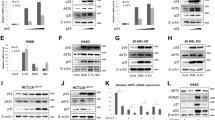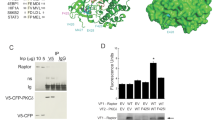Abstract
Apoptosis signal-regulating kinase 1 (ASK1), a member of the mitogen-activated protein kinase kinase kinase family, plays a critical role in mediating apoptosis signals initiated by a variety of death stimuli such as hydrogen peroxide and tumor necrosis factor-α. Owing to its critical role in inducing apoptosis, the activity of ASK1 is tightly regulated by various mechanisms such as post-translational modifications and protein–protein interactions. Here we describe the identification of G1 to S phase transition protein 1 (GSPT1), which is associated with protein translation, as a regulator of ASK1. GSPT1 interacts with ASK1 and enhances ASK1-induced apoptotic activity through the activation of caspase-3. In vitro kinase assay data show that GSPT1 enhances ASK1 autophosphorylation and its kinase activity. Cell cycle-dependent GSPT1 induction and small interfering RNA analyses show that ASK1 autophosphorylation is dependent on the expression level of endogenous GSPT1 in cells. GSPT1 inhibits the binding of ASK1 to the 14-3-3 protein, an ASK1 inhibitor, while GSPT1 has no effect on the interaction between ASK1 and TRAF2, a C-terminal-binding activator of ASK1. Thus, our results reveal a novel role of GSPT1 in the regulation of ASK1-mediated apoptosis.
This is a preview of subscription content, access via your institution
Access options
Subscribe to this journal
Receive 50 print issues and online access
$259.00 per year
only $5.18 per issue
Buy this article
- Purchase on Springer Link
- Instant access to full article PDF
Prices may be subject to local taxes which are calculated during checkout






Similar content being viewed by others
References
Bell LA, Ryan KM . (2004). Life and death decisions by E2F-1. Cell Death Differ 11: 137–142.
Chang HY, Nishitoh H, Yang X, Ichijo H, Baltimore D . (1998). Activation of apoptosis signal-regulating kinase 1 (ASK1) by the adapter protein Daxx. Science 281: 1860–1863.
Chauvin C, Salhi S, Le Goff C, Viranaicken W, Diop D, Jean-Jean O . (2005). Involvement of human release factors eRF3a and eRF3b in translation termination and regulation of the termination complex formation. Mol Cell Biol 25: 5801–5811.
Cho S, Ko HM, Kim JM, Lee JA, Park JE, Jang MS et al. (2004). Positive regulation of apoptosis signal-regulating kinase 1 by hD53L1. J Biol Chem 279: 16050–16056.
Du L, Lyle CS, Obey TB, Gaarde WA, Muir JA, Bennett BL et al. (2004). Inhibition of cell proliferation and cell cycle progression by specific inhibition of basal JNK activity: evidence that mitotic Bcl-2 phosphorylation is JNK-independent. J Biol Chem 279: 11957–11966.
Fu H, Subramanian RR, Masters SC . (2000). 14-3-3 proteins: structure, function, and regulation. Annu Rev Pharmacol Toxicol 40: 617–647.
Goldman EH, Chen L, Fu H . (2004). Activation of apoptosis signal-regulating kinase 1 by reactive oxygen species through dephosphorylation at serine 967 and 14-3-3 dissociation. J Biol Chem 279: 10442–10449.
Gyuris J, Golemis E, Chertkov H, Brent R . (1993). Cdi1, a human G1 and S phase protein phosphatase that associates with Cdk2. Cell 75: 791–803.
Hegde R, Srinivasula SM, Datta P, Madesh M, Wassell R, Zhang Z et al. (2003). The polypeptide chain-releasing factor GSPT1/eRF3 is proteolytically processed into an IAP-binding protein. J Biol Chem 278: 38699–38706.
Hoshino S, Imai M, Kobayashi T, Uchida N, Katada T . (1999). The eukaryotic polypeptide chain releasing factor (eRF3/GSPT) carrying the translation termination signal to the 3′-poly(A) tail of mRNA. Direct association of erf3/GSPT with polyadenylate-binding protein. J Biol Chem 274: 16677–16680.
Hoshino S, Imai M, Mizutani M, Kikuchi Y, Hanaoka F, Ui M et al. (1998). Molecular cloning of a novel member of the eukaryotic polypeptide chain-releasing factors (eRF). Its identification as eRF3 interacting with eRF1. J Biol Chem 273: 22254–22259.
Hoshino S, Miyazawa H, Enomoto T, Hanaoka F, Kikuchi Y, Kikuchi A et al. (1989). A human homologue of the yeast GST1 gene codes for a GTP-binding protein and is expressed in a proliferation-dependent manner in mammalian cells. EMBO J 8: 3807–3814.
Ichijo H, Nishida E, Irie K, ten Dijke P, Saitoh M, Moriguchi T et al. (1997). Induction of apoptosis by ASK1, a mammalian MAPKKK that activates SAPK/JNK and p38 signaling pathways. Science 275: 90–94.
Kikuchi Y, Shimatake H, Kikuchi A . (1988). A yeast gene required for the G1-to-S transition encodes a protein containing an A-kinase target site and GTPase domain. EMBO J 7: 1175–1182.
Ko YG, Kang YS, Park H, Seol W, Kim J, Kim T et al. (2001). Apoptosis signal-regulating kinase 1 controls the proapoptotic function of death-associated protein (Daxx) in the cytoplasm. J Biol Chem 276: 39103–39106.
Liu H, Nishitoh H, Ichijo H, Kyriakis JM . (2000). Activation of apoptosis signal-regulating kinase 1 (ASK1) by tumor necrosis factor receptor-associated factor 2 requires prior dissociation of the ASK1 inhibitor thioredoxin. Mol Cell Biol 20: 2198–2208.
Malta-Vacas J, Aires C, Costa P, Conde AR, Ramos S, Martins AP et al. (2005). Differential expression of the eukaryotic release factor 3 (eRF3/GSPT1) according to gastric cancer histological types. J Clin Pathol 58: 621–625.
Nishitoh H, Matsuzawa A, Tobiume K, Saegusa K, Takeda K, Inoue K et al. (2002). ASK1 is essential for endoplasmic reticulum stress-induced neuronal cell death triggered by expanded polyglutamine repeats. Genes Dev 16: 1345–1355.
Saitoh M, Nishitoh H, Fujii M, Takeda K, Tobiume K, Sawada Y et al. (1998). Mammalian thioredoxin is a direct inhibitor of apoptosis signal-regulating kinase (ASK) 1. EMBO J 17: 2596–2606.
Song JJ, Rhee JG, Suntharalingam M, Walsh SA, Spitz DR, Lee YJ . (2002). Role of glutaredoxin in metabolic oxidative stress. Glutaredoxin as a sensor of oxidative stress mediated by H2O2. J Biol Chem 277: 46566–46575.
Wang XS, Diener K, Tan TH, Yao Z . (1998). MAPKKK6, a novel mitogen-activated protein kinase kinase kinase, that associates with MAPKKK5. Biochem Biophys Res Commun 253: 33–37.
Zhang L, Chen J, Fu H . (1999). Suppression of apoptosis signal-regulating kinase 1-induced cell death by 14-3-3 proteins. Proc Natl Acad Sci USA 96: 8511–8515.
Acknowledgements
We thank Dr Hidenori Ichijo for HA-ASK1 and ASK1K709R expression plasmids. This work was supported by a grant of the Korea Health 21 R&D Project, Ministry of Health & Welfare, Republic of Korea (01-PJ10-PG6-01GN16-0005) (to SC) and by MOCIE grants from Intelligence Bioinformatics and Application Center (TGW0200513), KRIBB (to BP).
Author information
Authors and Affiliations
Corresponding authors
Additional information
Supplementary Information accompanies the paper on the Oncogene website (http://www.nature.com/onc).
Rights and permissions
About this article
Cite this article
Lee, J., Park, J., Lee, D. et al. G1 to S phase transition protein 1 induces apoptosis signal-regulating kinase 1 activation by dissociating 14-3-3 from ASK1. Oncogene 27, 1297–1305 (2008). https://doi.org/10.1038/sj.onc.1210740
Received:
Revised:
Accepted:
Published:
Issue Date:
DOI: https://doi.org/10.1038/sj.onc.1210740
Keywords
This article is cited by
-
GSPT1 Functions as a Tumor Promoter in Human Liver Cancer
Current Medical Science (2023)
-
Predicting chemosensitivity using drug perturbed gene dynamics
BMC Bioinformatics (2021)
-
Cell cycle-dependent Cdc25C phosphatase determines cell survival by regulating apoptosis signal-regulating kinase 1
Cell Death & Differentiation (2015)
-
Targeting 14-3-3zeta in cancer therapy
Cancer Gene Therapy (2012)
-
Translation termination factor eRF3 is targeted for caspase-mediated proteolytic cleavage and degradation during DNA damage-induced apoptosis
Apoptosis (2012)



